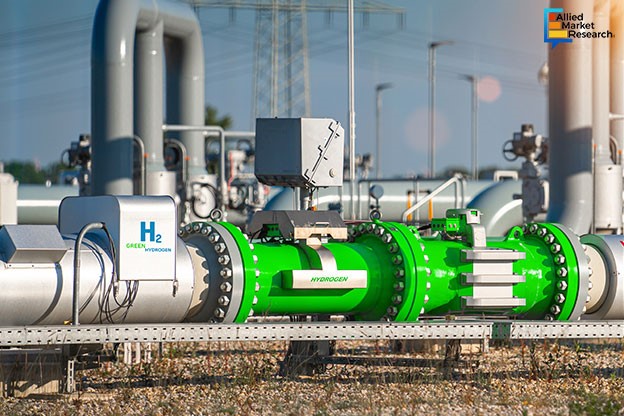Why Should Green Hydrogen Manufacturers Incorporate AI in Their Manufacturing Operations?

7 May
2024
Highlights
- Introduction
- Role of AI in green hydrogen production
- Partnership and service launch
Green hydrogen is generated through electrolysis, a process that splits water into its elemental components; hydrogen and oxygen. This process requires electrical current, which is sourced from renewable energy such as solar, hydroelectric, nuclear, or wind power. By utilizing renewable energy, this production method ensures that hydrogen is generated with minimal CO2 emissions. Green hydrogen finds wide application across various sectors, including industrial processes, heating, energy storage, alternative fuel production, and transportation (EVs). Its usage promotes emission reduction and supports the transition toward a more sustainable energy system.
Solid oxide electrolyzers are utilized in green hydrogen production due to their high efficiency and operational benefits. In addition, they efficiently utilize the heat available at elevated temperatures, reducing the amount of electrical energy needed to generate hydrogen from water. The combination of high efficiency and cost-effectiveness makes solid oxide electrolyzers a preferred choice for green hydrogen production. Owing to these advantages, the solid oxide electrolyzer segment is projected to manifest a notable CAGR of 51.10% by 2032.
Integration of AI in green hydrogen production
Artificial Intelligence (AI) holds the potential to play a significant role in optimizing the production of green hydrogen, making it more efficient and cost-effective.
Energy management
Integrating AI with energy management systems optimizes hydrogen production on the basis of demand and availability of renewable energy sources. This approach effectively reduces production costs, enhancing the competitiveness of green hydrogen compared to traditional fossil fuels.
Optimization of process
The production of hydrogen comprises multiple intricate processes, and AI algorithms optimize these processes by forecasting and regulating the parameters that impact the yield and quality of hydrogen. This optimization effectively reduces energy consumption and enhances the efficiency of the production process.
Renewable energy projection
One of the key challenges in green hydrogen production is the intermittent nature of renewable energy sources. AI algorithms aid in forecasting the availability of these sources, such as solar and wind, thereby optimizing hydrogen production.
Digital twin technology has gained traction
Digital twins of the plant integrate data from every layer of the technology stack to provide a comprehensive, multi-visual experience that spans the entire asset lifecycle, from capital projects to operations. This contextualized approach offers valuable insights and enhances decision-making processes. AI revolutionizes digital twins by offering insights beyond the capabilities of real-world sensors. It enhances digital twins to explore what-if scenarios, conduct simulations, and predict future values, providing inaccessible insights.
Energy management system for low energy consumption
EMS, or Energy Management Systems, offer an efficient pathway to integrate hydrogen production with renewable generation and electric grids. The primary objective is to minimize energy consumption, reduce operational costs (OPEX), and maximize green hydrogen production at the plant.
Saudi Arabia leads the green hydrogen sector
Saudi Arabia's commitment to renewable energy projects and decarbonization initiatives drives the rapid growth of the green hydrogen sector across the country. Significant investments have been made in renewable energy projects, particularly focusing on solar and wind power. These projects are projected to supply required renewable energy for green hydrogen production by fueling the growth of the green hydrogen industry in Saudi Arabia. As a result, the Saudi Arabia Green Hydrogen industry is projected to experience the fastest Compound Annual Growth Rate (CAGR) of 50.30% from 2023 to 2032.
Frontrunner's tactics to sustain the competitive industry
Top entities in the global green hydrogen industry have adopted novel strategies to strengthen their presence in the dynamic industry. These strategies involve mergers, new product launches, investments in R&D, partnerships, acquisitions, and partnerships. For instance, in May 2024, major power producer, Uniper and Copenhagen Infrastructure Partners (CIP), a prominent global energy merchant, formed a partnership to promote collaboration in the transportation, marketing, and production of green hydrogen from the HØST PtX Esbjerg project. Located on the Danish West Coast, this initiative aims to provide green hydrogen to the German industry.
To conclude, green hydrogen finds wide application across various sectors, including industrial processes, heating, energy storage, alternative fuel production, and transportation. Its usage promotes emission reduction and supports the transition toward a more sustainable energy system. Moreover, the integration of AI in green hydrogen production boosts the efficiency of products.
Feel free to reach us for detailed insights into the global green hydrogen industry.

Koyel Ghosh
Author’s Bio- Koyel Ghosh is a blogger with a strong passion and enjoys writing in miscellaneous domains, as she believes it lets her explore a wide variety of niches. She has an innate interest in creativity and enjoys experimenting with different writing styles. A writer who never stops imagining, she has been serving the corporate industry for the last five years.
Avenue: Entire Library membership of Allied Market Research Reports at your disposal
- Avenue is an innovative subscription-based online report database.
- Avail an online access to the entire library of syndicated reports on more than 2,000 niche industries and company profiles on more than 12,000 firms across 11 domains.
- A cost-effective model tailored for entrepreneurs, investors, and students & researchers at universities.
- Request customizations, suggest new reports, and avail analyst support as per your requirements.
- Get an access to the library of reports at any time from any device and anywhere.
Related Post
-
How are Submarine Cables Transforming Global Connectivity with Enhanced User Experience?
-
Endoscopy Procedures: Transformations in Techniques and Applications
-
AI-Powered Video Analytics: How the Product Actually Works for enterprises
-
Painting Robots: Transforming Precision Coating and Creative Applications
-
Innovations in Pharmacovigilance Systems Advancing Patient Safety
-
Understanding Edge Security: Keeping Data Safe Near the Source
-
Exploring the Use and Advancements of 3D Laser Scanners in Professional Applications
-
Reinforcing Industrial Controls with Smarter Tools and Training








